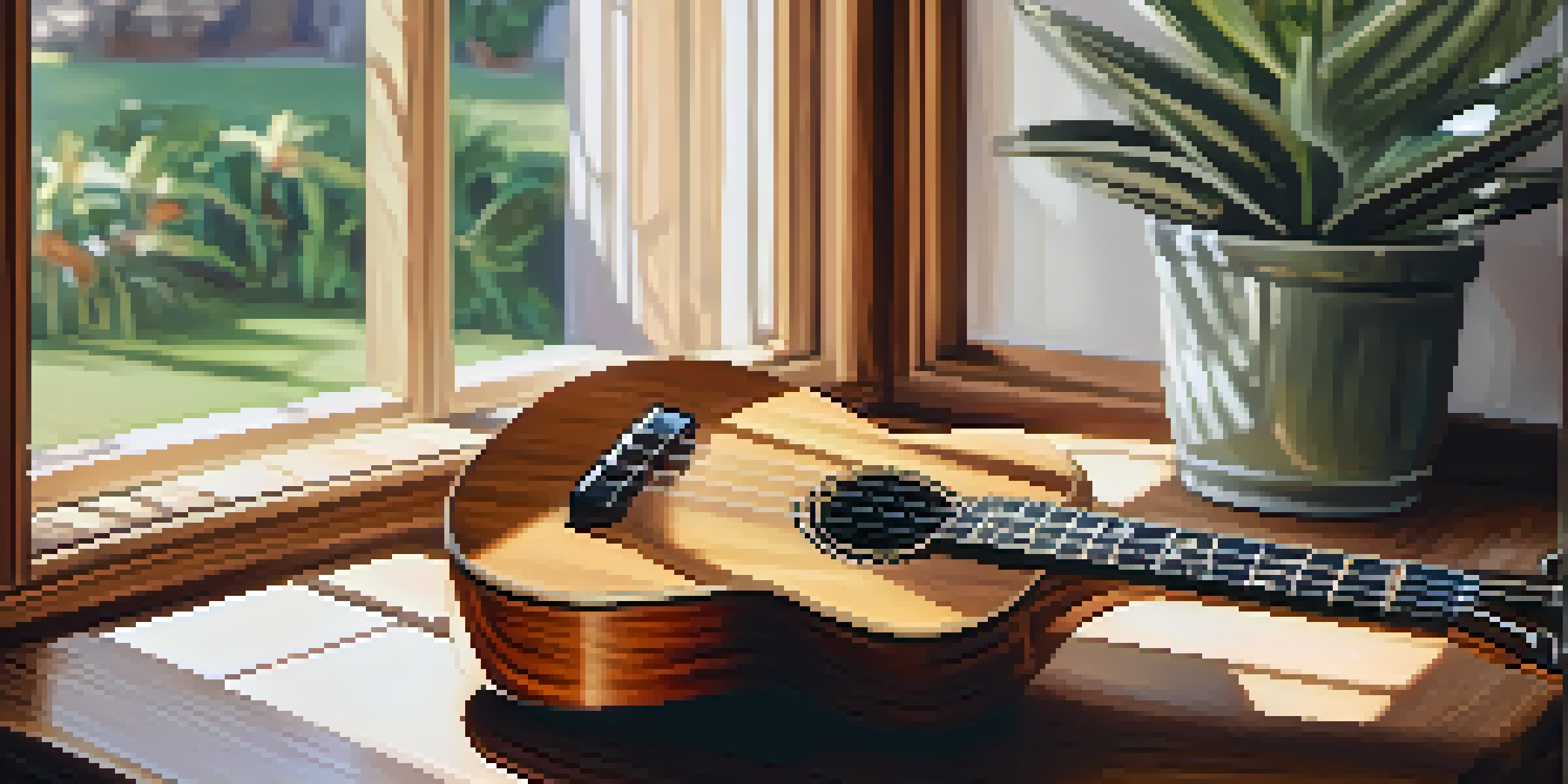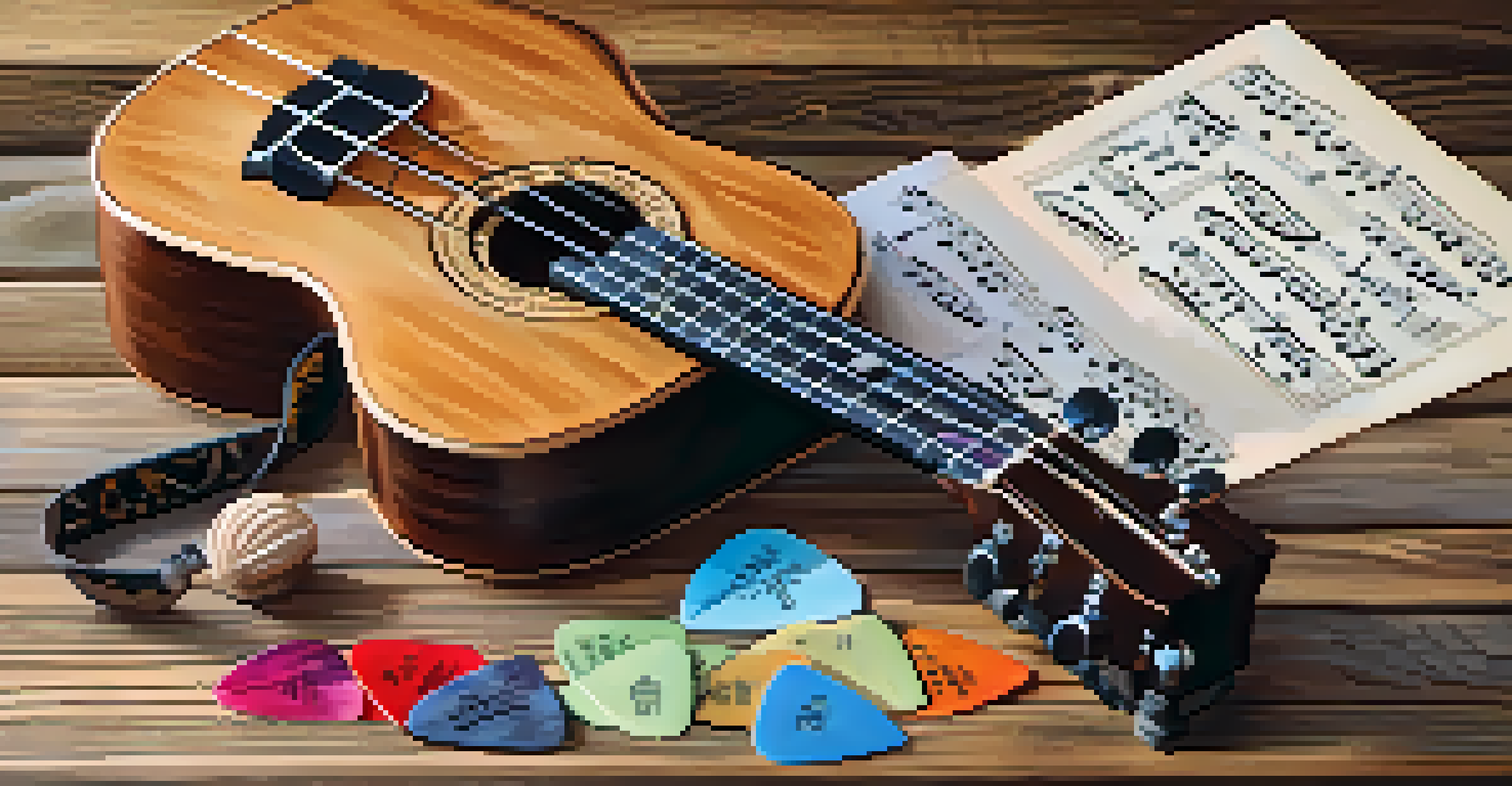How to Hold a Ukulele: A Beginner's Guide to Proper Technique

Understanding the Ukulele: A Brief Introduction
Before diving into how to hold a ukulele, it’s important to understand what it is. The ukulele is a small, four-stringed instrument that originated in Hawaii, often associated with cheerful melodies and a light-hearted vibe. Its compact size makes it a favorite among musicians of all ages, particularly beginners who are just starting their musical journey.
Music is the shorthand of emotion.
The ukulele comes in four main sizes: soprano, concert, tenor, and baritone, each offering a unique sound and feel. Beginners typically start with the soprano or concert ukulele because they are more manageable and have a bright, cheerful tone. Understanding your instrument is the first step to mastering how to hold it correctly.
Now that we have a bit of background, let’s explore the importance of proper technique. Holding your ukulele correctly can make a significant difference in your comfort and ability to produce beautiful music, so let’s get started!
Finding the Right Position: Comfort is Key
The first step in holding a ukulele is finding a comfortable position. Whether you’re sitting or standing, ensure that you feel relaxed, as tension can hinder your playing. If you’re sitting, it’s best to sit up straight with your feet flat on the ground, creating a stable base.

When holding the ukulele, it should rest against your chest, with the body of the instrument aligned with your torso. This position not only provides support but also allows your arms to move freely, enabling easy access to the strings and fretboard. Try experimenting with different angles to find what feels best for you.
Understanding Ukulele Basics
Familiarizing yourself with the ukulele's size and sound is essential for beginners.
Remember, your comfort is essential for enjoying your music-making experience. So, take your time to adjust and settle into a position that feels natural for you.
Placement of the Ukulele: Where to Position It
Proper placement of the ukulele on your body is crucial for effective playing. The body of the ukulele should rest on your right leg if you’re sitting down, or against your chest if you’re standing. This allows for better control and a more comfortable reach to the strings.
The beautiful thing about learning is that no one can take it away from you.
It’s important to keep the neck of the ukulele angled slightly upwards. This positioning helps you access the fretboard easily while playing chords or notes. Keeping the ukulele at an angle also minimizes strain on your wrists, making your playing experience more enjoyable.
Finding the right position will set the stage for your practice and performance, so don’t rush this step. Take the time to adjust and make the instrument feel like an extension of yourself.
Using Your Fretting Hand: The Right Grip
Your fretting hand is essential for playing chords and notes, so knowing how to grip the ukulele properly is vital. Start by positioning your thumb on the back of the neck for support while your fingers press down on the strings. This grip allows for greater control and helps you achieve clear notes.
Avoid tensing your fingers or wrist; instead, keep them relaxed to ensure fluid movement. Your fingers should be curved and positioned so that the fingertips press down just behind the fret. This technique will help produce a clean sound without buzzing.
Proper Grip and Positioning
Finding a comfortable hold and correct placement of the ukulele enhances your playing experience.
As you practice, pay attention to how your hand feels. The right grip will feel natural and comfortable, allowing you to focus on making music rather than struggling with your technique.
Strumming Hand Position: Finding Your Rhythm
Your strumming hand plays a crucial role in producing sound, so positioning it correctly is key. When you strum, it’s important to use your thumb or fingers—whichever feels more comfortable for you. Position your hand above the strings, ready to create those beautiful melodies.
For a relaxed strumming motion, let your wrist do the work rather than your arm. This will help you maintain a fluid motion, allowing for a more rhythmic and consistent strumming pattern. Experiment with different strumming techniques to find what suits your style.
As you develop your strumming technique, practice keeping your other hand steady on the fretboard. This will help you transition between chords smoothly while maintaining a steady rhythm.
Common Mistakes to Avoid: Tips for Beginners
As with any new skill, beginners often make common mistakes when holding a ukulele. One frequent error is gripping the neck too tightly, which can lead to tension and discomfort. Instead, focus on a relaxed grip that allows for easy movement and control.
Another mistake is positioning the ukulele too low, which can make it challenging to reach the frets and strings. Ensure the instrument is at a comfortable height that allows you to access all areas easily. Adjusting the placement can greatly improve your playing experience.
Consistency in Practice Matters
Regular practice helps reinforce proper technique and builds muscle memory for smoother playing.
Being aware of these common pitfalls will help you develop a better technique right from the start. Remember, practice makes perfect, so don’t be discouraged if it takes time to find your groove.
Practicing Your Technique: Consistency is Essential
Now that you understand how to hold the ukulele properly, practice is essential for mastering the technique. Set aside time each day to play, focusing on your grip and positioning. Consistency will help reinforce muscle memory, making it easier to play comfortably over time.
Incorporate exercises that focus on transitioning between chords, ensuring that you maintain the correct positioning throughout. This will not only improve your technique but also enhance your overall playing skills. Consider starting with simple songs to keep your practice engaging.

As you practice, don’t forget to have fun! Enjoying the process is just as important as perfecting your technique. Celebrate your progress, no matter how small, and keep strumming!